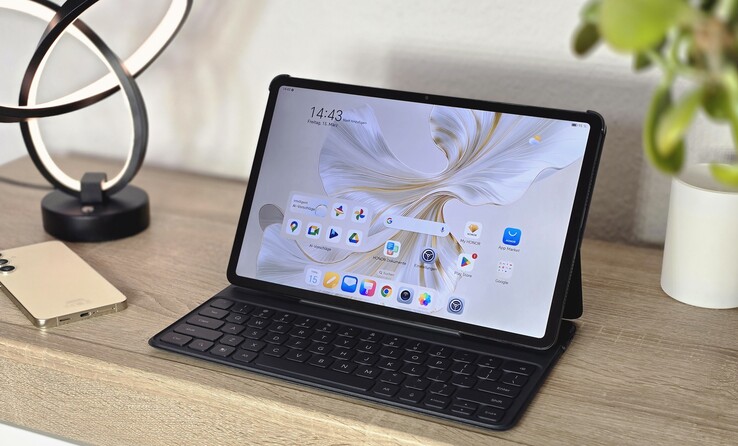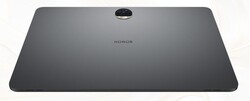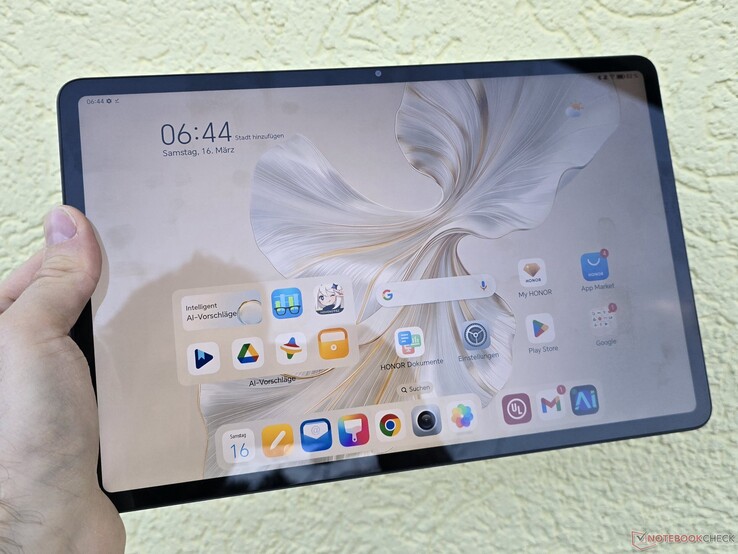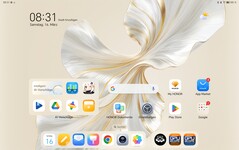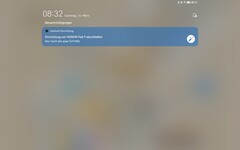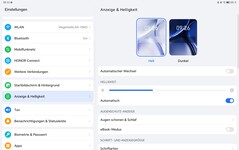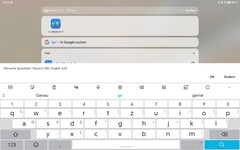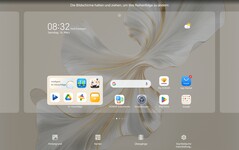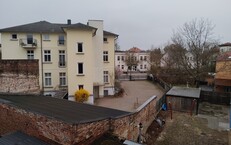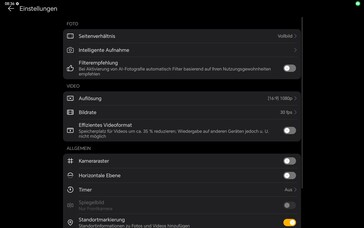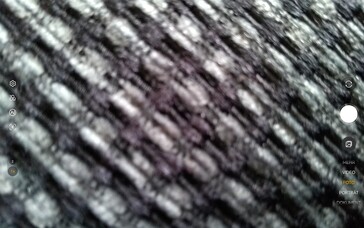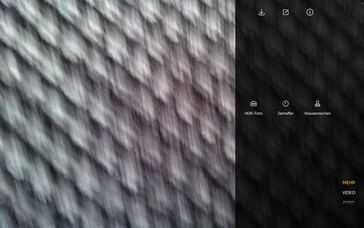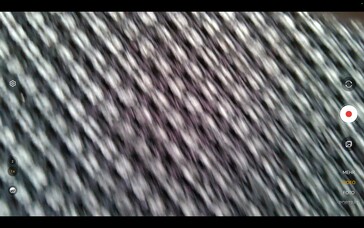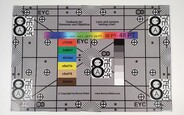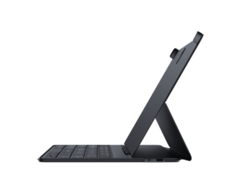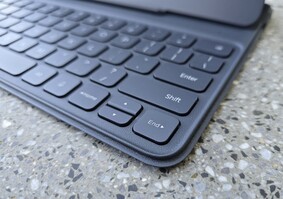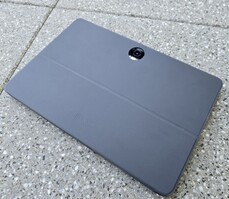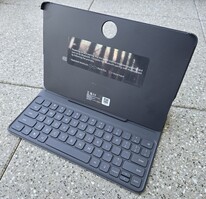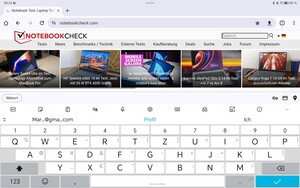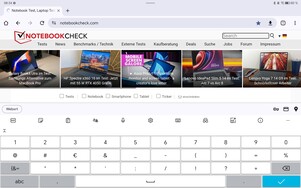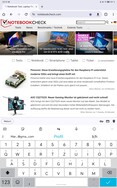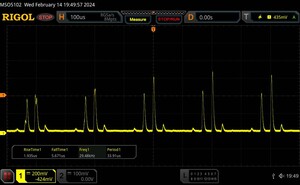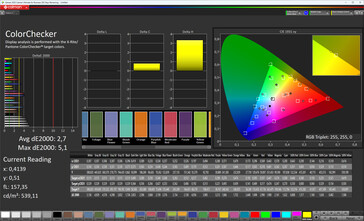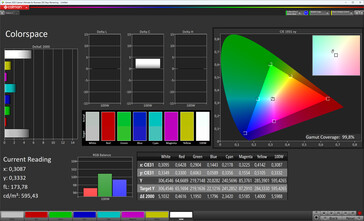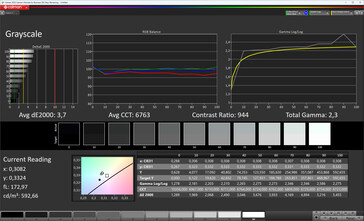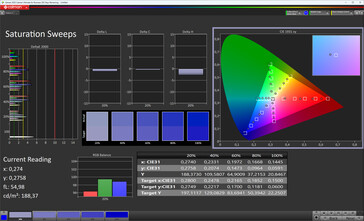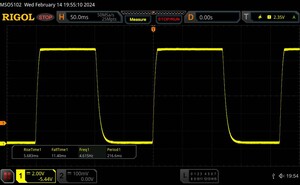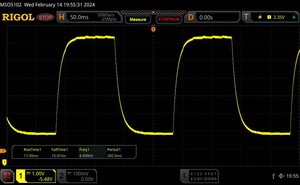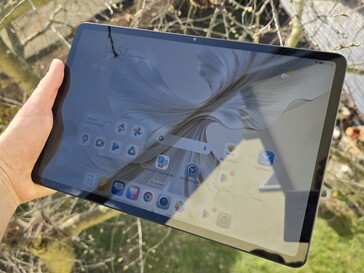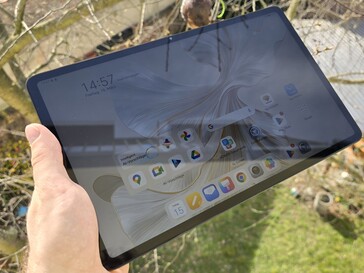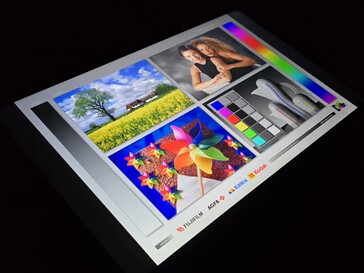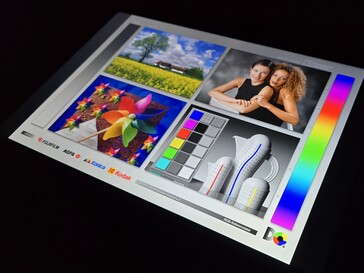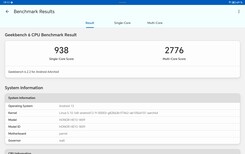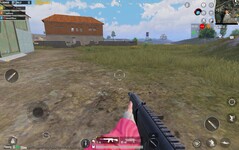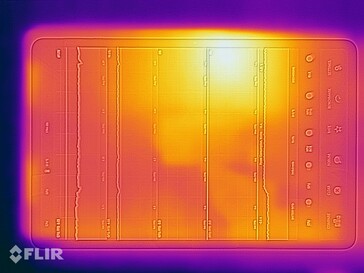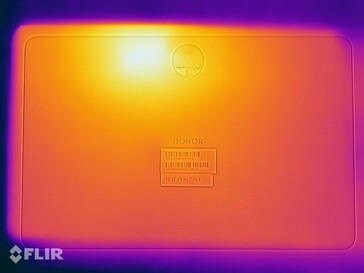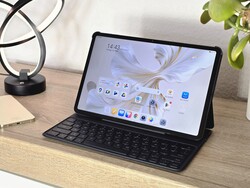Honor Pad 9 review - Large tablet with exceptional display and fantastic sound at a low price
The successor to the Honor Pad 8 is only marketed in Europe in a version with 8 GB RAM and 256 GB internal memory. For an RRP of 350 euros, the mid-range tablet has a very large and high-resolution display - in figures, the IPS panel measures 12.1 inches diagonally and offers 2,560 x 1,600 pixels. The manufacturer also promises TÜV Rheinland-certified eye protection thanks to a flicker-free and low blue light display.
An 8,300 mAh battery is installed, which powers the Snapdragon 6 Gen 1 and delivers an endurance of around 11 hours. You can find out whether the Honor tablet impresses in our tests in the following review.
Possible competitors in comparison
Rating | Date | Model | Weight | Height | Size | Resolution | Price |
|---|---|---|---|---|---|---|---|
| 84.8 % v7 (old) | 03 / 2024 | Honor Pad 9 SD 6 Gen 1, Adreno 710 | 555 g | 6.96 mm | 12.10" | 2560x1600 | |
| 80.7 % v7 (old) | 01 / 2024 | Teclast T60 T7255 (T616), Mali-G57 MP1 | 570 g | 7.7 mm | 11.97" | 2000x1200 | |
| 86.5 % v7 (old) | 09 / 2023 | Huawei MatePad 11.5 SD 7 Gen 1, Adreno 644 | 499 g | 6.85 mm | 11.50" | 2200x1440 | |
| 85.2 % v7 (old) | 09 / 2023 | Lenovo Tab P12 Dimensity 7050, Mali-G68 MP4 | 615 g | 6.9 mm | 12.70" | 2944x1840 | |
| 81.7 % v7 (old) | 11 / 2022 | Honor Pad 8 SD 680, Adreno 610 | 520 g | 6.9 mm | 12.00" | 2000x1200 |
Case - Honor Pad 9 with metal
The Honor Pad 9 is less than 7 millimeters thin and relatively light for a 12.1-inch tablet at just 555 grams. Although the Pad 9 is a mid-range device, the metal casing means there are hardly any compromises in terms of feel. The build quality is impressive, but there is no IP certification.
The edges around the IPS panel are kept quite narrow, resulting in a pleasing screen-to-body ratio of just under 85%. Honor does not specify which protective glass has been installed.
Features - Honor tablet without memory expansion
The 256 GB UFS 3.1 memory has an available capacity of 224 GB due to the operating system and some pre-installed apps. Storage media can be connected via the built-in USB 2.0 port using USB-OTG, but expansion using microSD cards is not possible. Data transfer via the USB port is very slow - we only measured 30 MB/s in the test. However, the exFAT file system and NTFS, which is preferred by Microsoft systems, are supported.
Software - Honor Pad 9 with Android 13
The operating system on our test device is the outdated Android 13 with the security patches from February 2024 and Magic UI (V7.2). An upgrade to Android 14 and future versions is not possible in view of the update policy of the predecessor. The Pad 8, for example, continues to run Android 12 and will probably never receive a new operating system version. How long Honor intends to provide its mid-range tablet with security patches has also not been officially communicated, only that these will probably be rolled out quarterly.
Updates 25th March: Our request to Honor has been answered. The Pad 9 is set to receive a major update (to Android 14) and three years of security patches.
Communication - Honor tablet without GPS
The Honor Pad 9 only has Wi-Fi 5 available for connecting to a Wi-Fi network. The Lenovo Tab P12 or Huawei MatePad 11.5 with Wi-Fi 6 support both show that it is possible to deliver faster speeds in the mid-range. In conjunction with our reference router Asus ROG Rapture GT-AXE11000, Honor only enables transfer rates of around 350 MBit/s on average in the 5 GHz range, and therefore we see no progress compared to the Pad 8.
If you want to access the Internet on the move with your tablet, there is unfortunately no optional 5G version of the Honor Pad 9 and you will have to resort to a mobile hotspot as an alternative. The mid-range tablet from Honor also does not allow positioning using a GNSS module.
| Networking | |
| iperf3 receive AXE11000 | |
| Huawei MatePad 11.5 | |
| Lenovo Tab P12 | |
| Honor Pad 9 | |
| Honor Pad 8 | |
| Teclast T60 | |
| iperf3 transmit AXE11000 | |
| Lenovo Tab P12 | |
| Huawei MatePad 11.5 | |
| Honor Pad 9 | |
| Teclast T60 | |
| Honor Pad 8 | |
Cameras - Honor Pad 9 with single cameras
The 8 MPix camera with a fixed focus built into the frame above the display relies on an f/2.2 aperture and delivers decent results in sufficient light. The single camera on the back performs slightly better, with a somewhat higher resolution of 13 MP. This also enables videos in UHD quality at 30 fps.
The main camera is well suited for taking pictures of documents, but buyers should not expect more from the Honor Pad 9. The somewhat reddish photos not only have a lack of sharpness, but also appear slightly noisy in daylight. In low light conditions, the 13 MP lens is quickly pushed to its limits despite the f/2.0 aperture. However, our analysis of the color reproduction under optimal illumination does not reveal any major points of criticism, and the built-in autofocus also works solidly in everyday use.
Image comparison
Choose a scene and navigate within the first image. One click changes the position on touchscreens. One click on the zoomed-in image opens the original in a new window. The first image shows the scaled photograph of the test device.
Main cameraMain cameraLow LightZoom 5x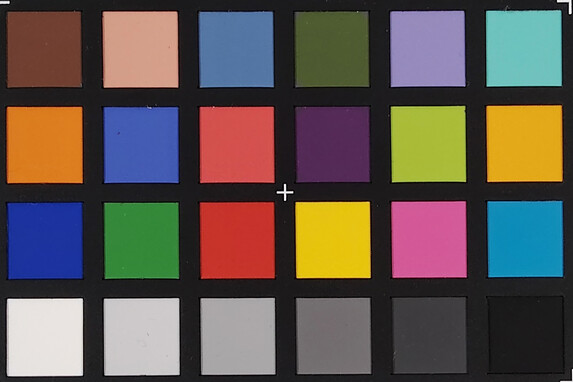

Accessories and warranty - Honor Pad 9 without power supply unit
Even before unpacking, the thin packaging of the Honor tablet suggests that the Pad 9 does not come with a power adapter in Germany - although this is included in other countries. Apart from a USB cable (USB-A to USB-C), there is only information material in the delivery box. However, Honor offers optional accessories for its mid-range tablet, such as a Smart Bluetooth Keyboard (RRP: 60 euros) or an Honor Pencil. The latter should be available from the end of March.
In Germany, the manufacturer offers a Warranty of 24 months on its tablets.
Input devices & operation - Honor-tablet with pen support
The panel of the Honor Pad 9 offers a high refresh rate of 120 Hz, which ensures a smooth display when scrolling or navigating through menus. However, the Honor tablet does exhibit the occasional stutter in everyday use. However, the touchscreen can be operated precisely. Thanks to the supported pen input, the Honor Pad 9 can also be used for taking notes.
According to the manufacturer, the glass surface has a special coating that reduces reflections from incident light. This should also benefit use with the stylus and create a particularly natural writing and drawing experience. A slight reduction in reflections is noticeable in direct comparison with the tablet competition but not comparable with the new Corning Gorilla Armor glass.
The user is authenticated via facial recognition using the front camera. This works very reliably in everyday use with sufficient light, and a total of five profiles can be saved. Unlocking using biometric finger identification is not possible.
Display - Honor Pad 9 relies on IPS
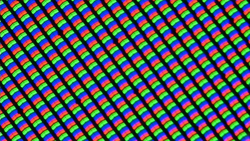
The 12.1-inch 120 Hz IPS panel has a 16:10 aspect ratio and a high resolution of 2,560 x 1,600 pixels. The maximum screen brightness of 613 cd/m² (APL18: 606 cd/m²) in our measurements is high for the price range, but the illumination provided is inhomogeneous. Thanks to the "Circadian Night" function, the screen of the Honor Pad 9 automatically reduces the amount of blue light after sunset to make reading in the dark easier on the eyes.
The Honor Pad 9 does not use PWM to control brightness, although we were able to detect high-frequency flickering in our measurement.
| |||||||||||||||||||||||||
Brightness Distribution: 87 %
Center on Battery: 613 cd/m²
Contrast: 1533:1 (Black: 0.4 cd/m²)
ΔE ColorChecker Calman: 2.7 | ∀{0.5-29.43 Ø4.78}
ΔE Greyscale Calman: 3.7 | ∀{0.09-98 Ø5}
99.8% sRGB (Calman 2D)
Gamma: 2.3
CCT: 6763 K
| Honor Pad 9 IPS LCD, 2560x1600, 12.1" | Teclast T60 IPS, 2000x1200, 12" | Huawei MatePad 11.5 IPS, 2200x1440, 11.5" | Lenovo Tab P12 LTPS, 2944x1840, 12.7" | Honor Pad 8 IPS, 2000x1200, 12" | |
|---|---|---|---|---|---|
| Screen | -1% | -22% | -5% | -38% | |
| Brightness middle (cd/m²) | 613 | 352 -43% | 472 -23% | 435 -29% | 379 -38% |
| Brightness (cd/m²) | 570 | 324 -43% | 432 -24% | 407 -29% | 382 -33% |
| Brightness Distribution (%) | 87 | 88 1% | 86 -1% | 89 2% | 84 -3% |
| Black Level * (cd/m²) | 0.4 | 0.25 37% | 0.44 -10% | 0.58 -45% | 0.3 25% |
| Contrast (:1) | 1533 | 1408 -8% | 1073 -30% | 750 -51% | 1263 -18% |
| Colorchecker dE 2000 * | 2.7 | 2.6 4% | 3.4 -26% | 1.5 44% | 4.76 -76% |
| Colorchecker dE 2000 max. * | 5.1 | 5.75 -13% | 6.6 -29% | 3.2 37% | 9.25 -81% |
| Greyscale dE 2000 * | 3.7 | 1.5 59% | 4.8 -30% | 2.4 35% | 6.7 -81% |
| Gamma | 2.3 96% | 2.319 95% | 2.41 91% | 2.2 100% | 2.234 98% |
| CCT | 6763 96% | 6747 96% | 7035 92% | 6546 99% | 8468 77% |
* ... smaller is better
Screen Flickering / PWM (Pulse-Width Modulation)
| Screen flickering / PWM detected | 29480 Hz | ≤ 57 % brightness setting | |
The display backlight flickers at 29480 Hz (worst case, e.g., utilizing PWM) Flickering detected at a brightness setting of 57 % and below. There should be no flickering or PWM above this brightness setting. The frequency of 29480 Hz is quite high, so most users sensitive to PWM should not notice any flickering. In comparison: 53 % of all tested devices do not use PWM to dim the display. If PWM was detected, an average of 8118 (minimum: 5 - maximum: 343500) Hz was measured. | |||
Measurement series with fixed zoom level and different brightness settings
In our display measurement with the Calman software and a spectrophotometer, the IPS display calibration is satisfactory, although the grayscale is outside the ideal range (<3) and has a slight green cast. The contrast ratio is around 1,500:1 thanks to the solid black value of 0.4 cd/m². The APL measurement (0.37 cd/m²) confirms that the 12.1-inch tablet has a slightly better contrast.
Display Response Times
| ↔ Response Time Black to White | ||
|---|---|---|
| 17.08 ms ... rise ↗ and fall ↘ combined | ↗ 5.683 ms rise | |
| ↘ 11.4 ms fall | ||
| The screen shows good response rates in our tests, but may be too slow for competitive gamers. In comparison, all tested devices range from 0.1 (minimum) to 240 (maximum) ms. » 38 % of all devices are better. This means that the measured response time is better than the average of all tested devices (20.2 ms). | ||
| ↔ Response Time 50% Grey to 80% Grey | ||
| 37.06 ms ... rise ↗ and fall ↘ combined | ↗ 17.09 ms rise | |
| ↘ 19.97 ms fall | ||
| The screen shows slow response rates in our tests and will be unsatisfactory for gamers. In comparison, all tested devices range from 0.165 (minimum) to 636 (maximum) ms. » 53 % of all devices are better. This means that the measured response time is worse than the average of all tested devices (31.6 ms). | ||
The viewing angle stability of the IPS panel is fine, and there are no noticeable changes to the colors. The Honor tablet is well-equipped for outdoor use. Content remains legible in direct sunlight thanks to the bright panel, but reflections on the glass surface should always be avoided despite the special display treatment.
Performance - Honor tablet with Qualcomm SoC
With the Snapdragon 6 Gen 1, the Honor Pad 9 offers a modern 4 nm chipset, but the Qualcomm SoC is still not really powerful. The results in our benchmark measurements are on par with the mid-range competition, especially in the Geekbench multi-core test, where a MediaTek Dimensity 7050 in the Lenovo Tab P12 performs weaker.
| CrossMark - Overall | |
| Average of class Tablet (227 - 2155, n=54, last 2 years) | |
| Average Qualcomm Snapdragon 6 Gen 1 (689 - 698, n=2) | |
| Honor Pad 9 | |
| Lenovo Tab P12 | |
| Honor Pad 8 | |
| Teclast T60 | |
| AImark - Score v3.x | |
| Average of class Tablet (138 - 55794, n=53, last 2 years) | |
| Huawei MatePad 11.5 | |
| Honor Pad 9 | |
| Average Qualcomm Snapdragon 6 Gen 1 (589 - 644, n=3) | |
| Lenovo Tab P12 | |
| Teclast T60 | |
| UL Procyon AI Inference for Android - Overall Score NNAPI | |
| Average of class Tablet (2597 - 76852, n=63, last 2 years) | |
| Huawei MatePad 11.5 | |
| Average Qualcomm Snapdragon 6 Gen 1 (7236 - 8191, n=4) | |
| Honor Pad 9 | |
| Lenovo Tab P12 | |
| Honor Pad 8 | |
| Teclast T60 | |
| Antutu v10 - Total Score | |
| Average of class Tablet (164396 - 3475590, n=71, last 2 years) | |
| Average Qualcomm Snapdragon 6 Gen 1 (490448 - 579582, n=4) | |
| Honor Pad 9 | |
| Teclast T60 | |
In the graphics tests, the Honor Pad 9 with its Qualcomm Adreno 710 achieves very competitive results. The values in the benchmarks are on par with the Lenovo Tab P12 with the Mali-G68 MP4.
GFXBench (DX / GLBenchmark) 2.7: T-Rex Onscreen | 1920x1080 T-Rex Offscreen
GFXBench 3.0: on screen Manhattan Onscreen OGL | 1920x1080 1080p Manhattan Offscreen
GFXBench 3.1: on screen Manhattan ES 3.1 Onscreen | 1920x1080 Manhattan ES 3.1 Offscreen
GFXBench: on screen Car Chase Onscreen | 1920x1080 Car Chase Offscreen | on screen Aztec Ruins High Tier Onscreen | 2560x1440 Aztec Ruins High Tier Offscreen | on screen Aztec Ruins Normal Tier Onscreen | 1920x1080 Aztec Ruins Normal Tier Offscreen | 3840x2160 4K Aztec Ruins High Tier Offscreen
| 3DMark / Wild Life Extreme Unlimited | |
| Huawei MatePad 11.5 | |
| Lenovo Tab P12 | |
| Honor Pad 9 | |
| Teclast T60 | |
| Honor Pad 8 | |
| 3DMark / Wild Life Extreme | |
| Huawei MatePad 11.5 | |
| Lenovo Tab P12 | |
| Honor Pad 9 | |
| Teclast T60 | |
| Honor Pad 8 | |
| 3DMark / Wild Life Unlimited Score | |
| Huawei MatePad 11.5 | |
| Honor Pad 9 | |
| Lenovo Tab P12 | |
| Teclast T60 | |
| Honor Pad 8 | |
| 3DMark / Wild Life Score | |
| Huawei MatePad 11.5 | |
| Honor Pad 9 | |
| Lenovo Tab P12 | |
| Teclast T60 | |
| Honor Pad 8 | |
| GFXBench (DX / GLBenchmark) 2.7 / T-Rex Onscreen | |
| Huawei MatePad 11.5 | |
| Honor Pad 9 | |
| Lenovo Tab P12 | |
| Honor Pad 8 | |
| Teclast T60 | |
| GFXBench (DX / GLBenchmark) 2.7 / T-Rex Offscreen | |
| Huawei MatePad 11.5 | |
| Honor Pad 9 | |
| Lenovo Tab P12 | |
| Honor Pad 8 | |
| Teclast T60 | |
| GFXBench 3.0 / Manhattan Onscreen OGL | |
| Huawei MatePad 11.5 | |
| Honor Pad 9 | |
| Lenovo Tab P12 | |
| Honor Pad 8 | |
| Teclast T60 | |
| GFXBench 3.0 / 1080p Manhattan Offscreen | |
| Huawei MatePad 11.5 | |
| Lenovo Tab P12 | |
| Honor Pad 9 | |
| Honor Pad 8 | |
| Teclast T60 | |
| GFXBench 3.1 / Manhattan ES 3.1 Onscreen | |
| Huawei MatePad 11.5 | |
| Honor Pad 9 | |
| Lenovo Tab P12 | |
| Honor Pad 8 | |
| Teclast T60 | |
| GFXBench 3.1 / Manhattan ES 3.1 Offscreen | |
| Huawei MatePad 11.5 | |
| Honor Pad 9 | |
| Lenovo Tab P12 | |
| Honor Pad 8 | |
| Teclast T60 | |
| GFXBench / Car Chase Onscreen | |
| Huawei MatePad 11.5 | |
| Honor Pad 9 | |
| Lenovo Tab P12 | |
| Honor Pad 8 | |
| Teclast T60 | |
| GFXBench / Car Chase Offscreen | |
| Huawei MatePad 11.5 | |
| Lenovo Tab P12 | |
| Honor Pad 9 | |
| Honor Pad 8 | |
| Teclast T60 | |
| GFXBench / Aztec Ruins High Tier Onscreen | |
| Huawei MatePad 11.5 | |
| Honor Pad 9 | |
| Lenovo Tab P12 | |
| Honor Pad 8 | |
| Teclast T60 | |
| GFXBench / Aztec Ruins High Tier Offscreen | |
| Huawei MatePad 11.5 | |
| Honor Pad 9 | |
| Lenovo Tab P12 | |
| Honor Pad 8 | |
| Teclast T60 | |
| GFXBench / Aztec Ruins Normal Tier Onscreen | |
| Huawei MatePad 11.5 | |
| Honor Pad 9 | |
| Lenovo Tab P12 | |
| Honor Pad 8 | |
| Teclast T60 | |
| GFXBench / Aztec Ruins Normal Tier Offscreen | |
| Huawei MatePad 11.5 | |
| Honor Pad 9 | |
| Lenovo Tab P12 | |
| Honor Pad 8 | |
| Teclast T60 | |
| GFXBench / 4K Aztec Ruins High Tier Offscreen | |
| Huawei MatePad 11.5 | |
| Honor Pad 9 | |
| Lenovo Tab P12 | |
| Honor Pad 8 | |
| Teclast T60 | |
| Jetstream 2 - 2.0 Total Score | |
| Average of class Tablet (22.3 - 395, n=67, last 2 years) | |
| Honor Pad 9 (Chrome 122) | |
| Average Qualcomm Snapdragon 6 Gen 1 (69.6 - 114.8, n=4) | |
| Huawei MatePad 11.5 (Edge 115) | |
| Lenovo Tab P12 (Chrome 115.0.5790.166) | |
| Teclast T60 (Chrome 120) | |
| Honor Pad 8 (Chrome 106.0.5249.126) | |
| WebXPRT 4 - Overall | |
| Average of class Tablet (26 - 376, n=72, last 2 years) | |
| Honor Pad 9 (Chrome 122) | |
| Huawei MatePad 11.5 (Edge 115) | |
| Average Qualcomm Snapdragon 6 Gen 1 (70 - 104, n=4) | |
| Lenovo Tab P12 (Chrome 115.0.5790.166) | |
| Teclast T60 (Chrome 120) | |
| Honor Pad 8 (Chrome 106.0.5249.126) | |
| WebXPRT 3 - Overall | |
| Average of class Tablet (39 - 480, n=25, last 2 years) | |
| Honor Pad 9 | |
| Average Qualcomm Snapdragon 6 Gen 1 (115 - 132, n=2) | |
| Lenovo Tab P12 (Chrome 115.0.5790.166) | |
| Honor Pad 8 (Chrome 106.0.5249.126) | |
| Speedometer 2.0 - Result 2.0 | |
| Average of class Tablet (2.59 - 790, n=56, last 2 years) | |
| Honor Pad 9 (Chrome 122) | |
| Lenovo Tab P12 (Chrome 115.0.5790.166) | |
| Average Qualcomm Snapdragon 6 Gen 1 (62.5 - 86.6, n=3) | |
| Huawei MatePad 11.5 (Edge 115) | |
| Teclast T60 (Chrome 120) | |
| Honor Pad 8 (Chrome 106.0.5249.126) | |
| Octane V2 - Total Score | |
| Average of class Tablet (763 - 138481, n=96, last 2 years) | |
| Honor Pad 9 (Chrome 122) | |
| Lenovo Tab P12 (Chrome 115.0.5790.166) | |
| Huawei MatePad 11.5 (Edge 115) | |
| Average Qualcomm Snapdragon 6 Gen 1 (24583 - 35376, n=4) | |
| Teclast T60 (Chrome 120) | |
| Honor Pad 8 (Chrome 106.0.5249.126) | |
| Mozilla Kraken 1.1 - Total | |
| Honor Pad 8 (Chrome 106.0.5249.126) | |
| Average of class Tablet (243 - 27101, n=81, last 2 years) | |
| Teclast T60 (Chrome 120) | |
| Lenovo Tab P12 (Chrome 115.0.5790.166) | |
| Huawei MatePad 11.5 (Edge 115) | |
| Average Qualcomm Snapdragon 6 Gen 1 (1099 - 1786, n=4) | |
| Honor Pad 9 (Chrome 122) | |
* ... smaller is better
The low price of the Honor Pad 9 is not noticeable when it comes to memory. The mid-range tablet uses the UFS 3.1 flash memory, which delivers high scores in the AndroBench benchmark compared to the competition.
| Honor Pad 9 | Teclast T60 | Huawei MatePad 11.5 | Lenovo Tab P12 | Honor Pad 8 | Average 256 GB UFS 3.1 Flash | Average of class Tablet | |
|---|---|---|---|---|---|---|---|
| AndroBench 3-5 | -78% | 0% | -26% | -39% | 5% | 0% | |
| Sequential Read 256KB (MB/s) | 1921.34 | 240.4 -87% | 1037.71 -46% | 956.07 -50% | 833.56 -57% | 1757 ? -9% | 1786 ? -7% |
| Sequential Write 256KB (MB/s) | 1222.83 | 230 -81% | 903.32 -26% | 776.24 -37% | 708.51 -42% | 1204 ? -2% | 1334 ? 9% |
| Random Read 4KB (MB/s) | 256.06 | 76.4 -70% | 297.25 16% | 241.23 -6% | 189.57 -26% | 287 ? 12% | 244 ? -5% |
| Random Write 4KB (MB/s) | 266.17 | 67.5 -75% | 418.84 57% | 234.58 -12% | 186.95 -30% | 318 ? 19% | 278 ? 4% |
Games - Honor tablet only manages 60 fps
According to our benchmark package, the Adreno 710 has to prove itself in gaming. We used the GameBench app to determine the exact frame rates for selected Android games.
PUBG mobile cannot be played in the current highest graphics setting (UHD); in HD mode, we measured a frame rate of 30 fps. Even at low details, the shooter is not much smoother at 40 fps.
Things look a little different with less demanding games. Dead Trigger 2 at least manages 60 fps. Genshin Impact also achieves 47 fps at the lowest graphics settings. If we increase the details, the fantasy action role-playing game achieves a frame rate of just 31 fps.
Emissions - Honor Pad 9 stays cool
Temperature
The casing of the Honor Pad 9 hardly heats up in everyday use, and even under load, the temperature increase is only very moderate. We use 3DMark to check the internal heat dissipation behavior.
The wild-life stress tests finish with a consistency of over 99 percent. A performance reduction is, therefore, rather unlikely even during longer gaming sessions.
(+) The maximum temperature on the upper side is 36.9 °C / 98 F, compared to the average of 33.7 °C / 93 F, ranging from 20.7 to 53.2 °C for the class Tablet.
(+) The bottom heats up to a maximum of 34.7 °C / 94 F, compared to the average of 33.2 °C / 92 F
(±) In idle usage, the average temperature for the upper side is 32.3 °C / 90 F, compared to the device average of 30 °C / 86 F.
3DMark Wild Life Stress Test
| 3DMark | |
| Wild Life Extreme Stress Test | |
| Huawei MatePad 11.5 | |
| Honor Pad 9 | |
| Lenovo Tab P12 | |
| Honor Pad 8 | |
| Teclast T60 | |
| Wild Life Stress Test Stability | |
| Honor Pad 8 | |
| Lenovo Tab P12 | |
| Huawei MatePad 11.5 | |
| Honor Pad 9 | |
| Teclast T60 | |
| Wild Life Unlimited Stress Test Stability | |
| Honor Pad 9 | |
Speaker
A highlight of the Honor tablet is the audio system with its eight speakers. Our measurements show a linear frequency curve for the mids and highs, although super tweeters break in somewhat. Bass is also present in the sound, which is very commendable for this price range.
A wired headphones can be connected via the USB-C port, while the Honor Pad 9 supports Bluetooth version 5.1 wirelessly. The supported audio codecs aren't listed in the specs.
Honor Pad 9 audio analysis
(+) | speakers can play relatively loud (89.1 dB)
Bass 100 - 315 Hz
(±) | reduced bass - on average 13.9% lower than median
(±) | linearity of bass is average (10.8% delta to prev. frequency)
Mids 400 - 2000 Hz
(+) | balanced mids - only 4.5% away from median
(+) | mids are linear (3.8% delta to prev. frequency)
Highs 2 - 16 kHz
(+) | balanced highs - only 1.7% away from median
(+) | highs are linear (3.6% delta to prev. frequency)
Overall 100 - 16.000 Hz
(+) | overall sound is linear (11.9% difference to median)
Compared to same class
» 15% of all tested devices in this class were better, 4% similar, 80% worse
» The best had a delta of 7%, average was 20%, worst was 129%
Compared to all devices tested
» 8% of all tested devices were better, 2% similar, 89% worse
» The best had a delta of 4%, average was 24%, worst was 134%
Honor Pad 8 audio analysis
(+) | speakers can play relatively loud (84 dB)
Bass 100 - 315 Hz
(-) | nearly no bass - on average 15% lower than median
(±) | linearity of bass is average (11.9% delta to prev. frequency)
Mids 400 - 2000 Hz
(+) | balanced mids - only 3.1% away from median
(+) | mids are linear (4% delta to prev. frequency)
Highs 2 - 16 kHz
(+) | balanced highs - only 1.6% away from median
(+) | highs are linear (3% delta to prev. frequency)
Overall 100 - 16.000 Hz
(+) | overall sound is linear (12.6% difference to median)
Compared to same class
» 20% of all tested devices in this class were better, 5% similar, 75% worse
» The best had a delta of 7%, average was 20%, worst was 129%
Compared to all devices tested
» 11% of all tested devices were better, 3% similar, 87% worse
» The best had a delta of 4%, average was 24%, worst was 134%
Energy management - Honor tablet with high consumption
Power consumption
The mid-range tablet has an 8,300 mAh battery, which can be charged with up to 35 watts via the USB Type-C port. We were able to fully recharge the Pad 9 with a power bank (PD 3.0, max. 100 watts) in around 3.5 hours.
At over 8 watts, the consumption is particularly inefficient and noticeably high at idle.
| Off / Standby | |
| Idle | |
| Load |
|
Key:
min: | |
| Honor Pad 9 8300 mAh | Teclast T60 8000 mAh | Huawei MatePad 11.5 7700 mAh | Lenovo Tab P12 10200 mAh | Honor Pad 8 7250 mAh | |
|---|---|---|---|---|---|
| Power Consumption | 53% | 24% | -4% | 57% | |
| Idle Minimum * (Watt) | 1.5 | 1.2 20% | 1.23 18% | 1.91 -27% | 1.1 27% |
| Idle Average * (Watt) | 8.39 | 1.4 83% | 4.44 47% | 7.94 5% | 1.5 82% |
| Idle Maximum * (Watt) | 8.46 | 1.7 80% | 4.49 47% | 8.12 4% | 2.1 75% |
| Load Average * (Watt) | 11.65 | 4.2 64% | 11.2 4% | 10.68 8% | 4.4 62% |
| Load Maximum * (Watt) | 11.67 | 9.5 19% | 11.32 3% | 12.69 -9% | 7.2 38% |
* ... smaller is better
Power consumption: Geekbench (150 cd/m²)
Power consumption: GFXBench (150 cd/m²)
Battery life
In our WLAN test with an adjusted display brightness of 150 cd/m², the Honor Pad 9 delivers the manufacturer's estimated endurance of 11 hours but does not last as long as the mid-range competition.
| Honor Pad 9 8300 mAh | Teclast T60 8000 mAh | Huawei MatePad 11.5 7700 mAh | Lenovo Tab P12 10200 mAh | Honor Pad 8 7250 mAh | |
|---|---|---|---|---|---|
| Battery runtime | |||||
| WiFi v1.3 (h) | 11 | 18.3 66% | 14.4 31% | 11.3 3% | 12.2 11% |
Pros
Cons
Verdict
If you are looking for a new mid-range tablet with a large display and appreciate a very appealing speaker system, the Honor Pad 9 could be the perfect companion for you. In addition to the high-quality feel, the Honor tablet impresses with its fast memory, low waste heat, and pen support. However, in view of the manufacturer's unclear update policy, those interested in the Pad 9 will have to come to terms with the lack of extensive software support. Lenovo shows that it can do better in this price range with its Tab P12.
The Honor Pad 9 is a powerful entertainer without looking to the future.
But even apart from the software, the Honor Pad 9 has to put up with criticism due to its reduced features (no GPS, no fingerprint sensor, ...). If you are willing to accept a slightly smaller screen, the Xiaomi Pad 6 is a better and more powerful alternative in the under 350 euro price segment thanks to WiFi 6 and USB 3.2. The processor installed in the Honor Pad 9 - Snapdragon 6 Gen 1 - is certainly not bad, but the system does not feel really powerful due to the high 1,600p resolution.
Updates 25th March: The Software section has been updated.
Price and availability
The Honor Pad 9 is available for a recommended retail price of 349.90 euros. At the time of testing, Honor is offering a 10% discount in the online store and the Smart Bluetooth Keyboard for free. Alternatively, the Honor tablet can be purchased from Amazon (DE).
Honor Pad 9
- 03/19/2024 v7 (old)
Marcus Herbrich
Transparency
The selection of devices to be reviewed is made by our editorial team. The test sample was provided to the author as a loan by the manufacturer or retailer for the purpose of this review. The lender had no influence on this review, nor did the manufacturer receive a copy of this review before publication. There was no obligation to publish this review. As an independent media company, Notebookcheck is not subjected to the authority of manufacturers, retailers or publishers.
This is how Notebookcheck is testing
Every year, Notebookcheck independently reviews hundreds of laptops and smartphones using standardized procedures to ensure that all results are comparable. We have continuously developed our test methods for around 20 years and set industry standards in the process. In our test labs, high-quality measuring equipment is utilized by experienced technicians and editors. These tests involve a multi-stage validation process. Our complex rating system is based on hundreds of well-founded measurements and benchmarks, which maintains objectivity. Further information on our test methods can be found here.




